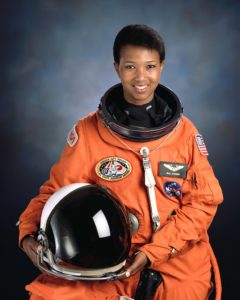Celebrating Black Humanists and Allies: Mae Jemison

In honor of Black History Month, we’ll be profiling an important contemporary Black humanist (or humanist ally) in a different field each week during the month of February. This week, we profile humanist ally, astronaut, engineer, physician, and scientist Mae Jemison.
Mae Carol Jemison became the first black woman astronaut at NASA in 1987 and the first black woman to travel to space in 1992, as a mission specialist on the Space Shuttle Endeavor.
She was born on October 17, 1956 in Decatur, Alabama, to a mother who was an elementary school teacher and a father who was a maintenance supervisor, and moved with her parents and two siblings to Chicago when she was three years old. Reportedly, she told her kindergarten teacher that she would be a scientist. Inspired by the Apollo missions and by watching Nichelle Nichols play Lt. Uhura on Star Trek, Jemison knew she wanted to travel to space at a young age. Growing up, she also studied dance, acted in school plays, and was a member of student government.
Entering Stanford University at the early age of sixteen, in addition to her studies, she became president of the Black Student Union and choreographed a production of Out of the Shadows, about the African American experience. She graduated with a BS in Engineering and a BA in African and African-American Studies and then went on to Cornell Medical School. While there, she led a study for the American Medical Student Association in Cuba, worked with Cambodian refugees in Thailand, and studied in Kenya. After earning her medical degree, Jemison joined the Peace Corps and served as a medical officer in West Africa for two years.
When she returned home from the Peace Corps, she opened a private practice but was inspired by Sally Ride’s trip to space and applied to NASA to become an astronaut. She was one of 15 people accepted out of 2,000 applications to join the space program in 1987, after NASA took a break in accepting new applicants following the Space Shuttle Challenger disaster.
Jemison and six other astronauts blasted off on September 12, 1992, made 127 orbits, and returned to Earth on September 20th. In a CNN interview in 2005, Jemison explained, “Once I got into space, I was feeling very comfortable in the universe. I felt like I had a right to be anywhere in this universe, that I belonged here as much as any speck of stardust, any comet, any planet.”
After serving for six years with NASA, she started The Jemison Group (a consulting organization that encourages science, technology and social change), The Jemison Institute for Advancing Technology in Developing Countries, an international space camp for students, and The Dorothy Jemison Foundation for Excellence (named for her mother). She has written several books, taught at Dartmouth College and Cornell University, and appeared in an episode of Star Trek: The Next Generation, invited by LeVar Burton. She makes regular speaking and public appearances to encourage interest in science.
Jemison has been inducted into the National Women’s Hall of Fame and the International Space Hall of Fame.
She encourages young people to get involved in science and imagine all their opportunities, saying, “Don’t let anyone rob you of your imagination, your creativity, or your curiosity. It’s your place in the world; it’s your life. Go on and do all you can with it, and make it the life you want to live.” Sounds like humanism!
